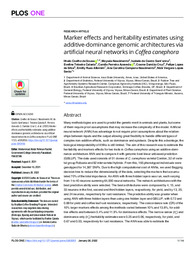Marker effects and heritability estimates using additive-dominance genomic architectures via artificial neural networks in Coffea canephora.
Marker effects and heritability estimates using additive-dominance genomic architectures via artificial neural networks in Coffea canephora.
Author(s): SOUSA, I. C. de; NASCIMENTO, M.; SANT’ANNA, I. de C.; CAIXETA, E. T.; AZEVEDO, C. F.; CRUZ, C. D.; SILVA, F. L. da; ALKIMIM, E. R.; NASCIMENTO, A. C. C.; SERÃO, N. V. L.
Summary: Many methodologies are used to predict the genetic merit in animals and plants, but some of them require priori assumptions that may increase the complexity of the model. Artificial neural network (ANN) has advantage to not require priori assumptions about the relationships between inputs and the output allowing great flexibility to handle different types of complex non-additive effects, such as dominance and epistasis. Despite this advantage, the biological interpretability of ANNs is still limited. The aim of this research was to estimate the heritability and markers effects for two traits in Coffea canephora using an additive-dominance architecture ANN and to compare it with genomic best linear unbiased prediction (GBLUP). The data used consists of 51 clones of C. canephora varietal Conilon, 32 of varietal group Robusta and 82 intervarietal hybrids. From this, 165 phenotyped individuals were genotyped for 14,387 SNPs. Due to the high computational cost of ANNs, we used Bagging decision tree to reduce the dimensionality of the data, selecting the markers that accumulated 70% of the total importance. An ANN with three hidden layers was run, each varying from 1 to 40 neurons summing 64,000 neural networks. The network architectures with the best predictive ability were selected. The best architectures were composed by 4, 15, and 33 neurons in the first, second and third hidden layers, respectively, for yield, and by 13, 20, and 24 neurons, respectively for rust resistance. The predictive ability was greater when using ANN with three hidden layers than using one hidden layer and GBLUP, with 0.72 and 0.88 for yield and coffee leaf rust resistance, respectively. The concordance rate (CR) of the 10% larger markers effects among the methods varied between 10% and 13.8%, for additive effects and between 5.4% and 11.9% for dominance effects. The narrow-sense (h2a ) and dominance-only (h2a ) heritability estimates were 0.25 and 0.06, respectively, for yield, and 0.67 and 0.03, respectively for rust resistance. The ANN was able to estimate the heritabilities from an additive-dominance genomic architectures and the ANN with three hidden layers obtained best predictive ability when compared with those obtained from GBLUP and ANN with one hidden layer.
Publication year: 2022
Types of publication: Journal article
Unit: Embrapa Coffee
Observation
Some of Embrapa's publications are published as ePub files. To read them, use or download one of the following free software options to your computer or mobile device. Android: Google Play Books; IOS: iBooks; Windows and Linux: Calibre.
Access other publications
Access the Agricultural Research Database (BDPA) to consult Embrapa's full library collection and records.
Visit Embrapa Bookstore to purchase books and other publications sold by Embrapa.

